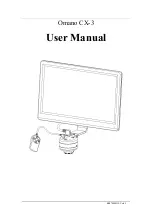
LEE JACKSON AMPLIFIERS
WWW.LEEJACKSON.COM
M-1000P Pedal
CONGRATULATIONS!
You have just purchased a very fine piece of professional audio equipment. We know you're
eager to crank up your new pedal and get
"THE SOUND"
but because of the many features and
complexity of the M-1000P, It sounds great as a Distortion Pedal, an Instrument Preamp, and is
awesome as a Direct Recording Preamp, We suggest you take a moment to read the manual first.
Once you get going, you can use this manual as a reference guide (keep it in your guitar case!).
Since the M-1000P has features that no other pedal has, we've tried to make this manual as
detailed as possible. At the same time we've organized it so you can get started right away.
Please take your first opportunity to read this manual thoroughly.
SIGNAL PATH OVERVIEW
Even though we've put a lot of features in your M-1000P, you only need to use those features that
suit your playing style. To help you understand your new pedal better, let's follow the path of
your guitar signal as it goes through the M-1000P (see diagram).
First we start at the "INPUT” jack. After our instrument signal goes in here we have a choice of
routes to take. We can go through "STAGE 11" where our gain is increased and also variable, or
we can bypass "STAGE 11" and go directly to preamp "VOLUME". This is the control that sets
the input sensitivity of the amplifier and allows us to access the "(Footswitch “CLEAN”)"
feature. When foot-switched, we bypass two gain stages to get that sparkling clean tone. Next we
travel through the tone controls adjusting the "TREBLE, MIDDLE, MID-SHIFT, and BASS"
response. This brings us to "Masters". These controls are where we set the pedal for the loudest
(lead) volume we wish to play at, and also where we set the level of signal to the effects loop, we
can preset a different volume (rhythm) for the pedal, or boost for solos. The “Loop Jack” is after
the Master Volumes, so the signal level that is going to your effects is set by the Masters, use a
stereo cord to include your outside loop of effects, “Tip” is send (output) and “Ring” is Return
(input).
Summary of Contents for Metaltronix M-1000P
Page 3: ......




















